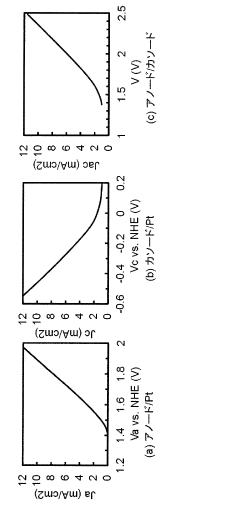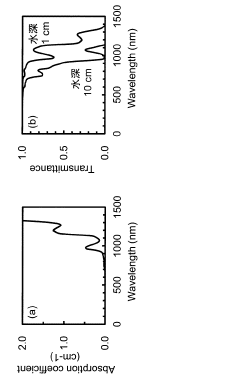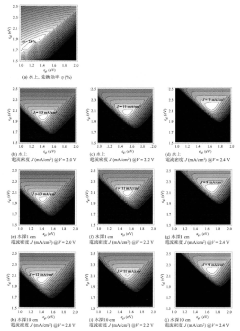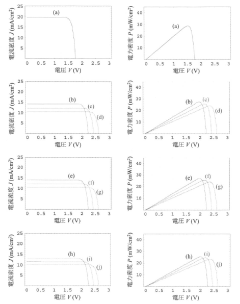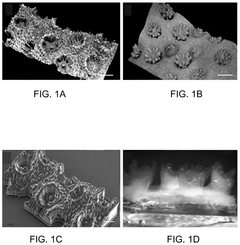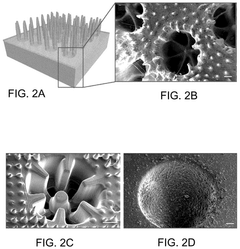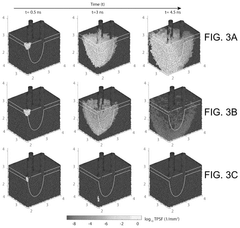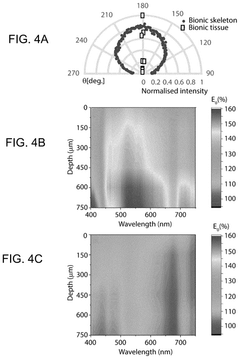Artificial Photosynthesis solutions for island nations.
SEP 4, 20259 MIN READ
Generate Your Research Report Instantly with AI Agent
Patsnap Eureka helps you evaluate technical feasibility & market potential.
Artificial Photosynthesis Background and Objectives
Artificial photosynthesis represents a biomimetic approach that aims to replicate the natural process of photosynthesis, wherein plants convert sunlight, water, and carbon dioxide into oxygen and energy-rich carbohydrates. This technology has evolved significantly since its conceptual inception in the early 20th century, with major breakthroughs occurring in the 1970s when researchers first demonstrated water splitting using titanium dioxide as a photocatalyst. The field has since expanded to encompass various approaches including photocatalytic systems, photoelectrochemical cells, and artificial leaf technologies.
For island nations, artificial photosynthesis presents a particularly compelling solution to multiple interconnected challenges. These geographically isolated territories often face energy insecurity due to limited fossil fuel resources, vulnerability to climate change impacts, and dependence on expensive imported energy. The technology evolution trend points toward increasingly efficient systems with higher solar-to-fuel conversion efficiencies, improved durability, and reduced costs—all critical factors for implementation in island contexts.
The primary technical objectives for artificial photosynthesis in island nations include developing systems that can operate efficiently in tropical maritime climates, withstand corrosive saltwater environments, and function with minimal maintenance requirements. Additionally, these systems must be scalable to meet the diverse energy needs of island communities while being resilient to extreme weather events that frequently affect these regions.
Beyond energy production, artificial photosynthesis technologies aim to address carbon dioxide reduction, potentially offering island nations a dual benefit of energy security and climate change mitigation. This aligns with many island nations' ambitious climate goals, as they are often at the forefront of advocating for global carbon emission reductions due to their heightened vulnerability to sea-level rise and extreme weather events.
Recent technological advancements have demonstrated promising progress, with laboratory-scale systems achieving solar-to-hydrogen conversion efficiencies exceeding 10%. However, the trajectory of development indicates that integrated systems combining water splitting with carbon dioxide reduction to produce liquid fuels or valuable chemicals represent the next frontier, potentially offering island nations sustainable alternatives to imported petroleum products.
The ultimate objective for artificial photosynthesis deployment in island nations is to create decentralized, renewable energy systems that can operate independently of fossil fuel imports, thereby enhancing energy sovereignty while simultaneously contributing to global carbon reduction efforts. This technology could potentially transform island economies by redirecting funds currently spent on energy imports toward local development priorities.
For island nations, artificial photosynthesis presents a particularly compelling solution to multiple interconnected challenges. These geographically isolated territories often face energy insecurity due to limited fossil fuel resources, vulnerability to climate change impacts, and dependence on expensive imported energy. The technology evolution trend points toward increasingly efficient systems with higher solar-to-fuel conversion efficiencies, improved durability, and reduced costs—all critical factors for implementation in island contexts.
The primary technical objectives for artificial photosynthesis in island nations include developing systems that can operate efficiently in tropical maritime climates, withstand corrosive saltwater environments, and function with minimal maintenance requirements. Additionally, these systems must be scalable to meet the diverse energy needs of island communities while being resilient to extreme weather events that frequently affect these regions.
Beyond energy production, artificial photosynthesis technologies aim to address carbon dioxide reduction, potentially offering island nations a dual benefit of energy security and climate change mitigation. This aligns with many island nations' ambitious climate goals, as they are often at the forefront of advocating for global carbon emission reductions due to their heightened vulnerability to sea-level rise and extreme weather events.
Recent technological advancements have demonstrated promising progress, with laboratory-scale systems achieving solar-to-hydrogen conversion efficiencies exceeding 10%. However, the trajectory of development indicates that integrated systems combining water splitting with carbon dioxide reduction to produce liquid fuels or valuable chemicals represent the next frontier, potentially offering island nations sustainable alternatives to imported petroleum products.
The ultimate objective for artificial photosynthesis deployment in island nations is to create decentralized, renewable energy systems that can operate independently of fossil fuel imports, thereby enhancing energy sovereignty while simultaneously contributing to global carbon reduction efforts. This technology could potentially transform island economies by redirecting funds currently spent on energy imports toward local development priorities.
Market Analysis for Island Energy Solutions
Island nations face unique energy challenges due to their geographical isolation, limited land resources, and vulnerability to climate change. The market for artificial photosynthesis solutions in these regions presents distinctive characteristics and opportunities that warrant careful analysis.
The global renewable energy market for island nations is projected to grow significantly, with artificial photosynthesis technologies potentially capturing a substantial segment. Currently, most island nations rely heavily on imported fossil fuels, spending between 15-20% of their GDP on energy imports. This dependency creates economic vulnerability and energy insecurity, driving strong demand for sustainable alternatives.
Artificial photosynthesis solutions align perfectly with the abundant solar resources available to most island nations. The market potential is particularly strong in the Pacific, Caribbean, and Indian Ocean regions, where solar irradiance levels are consistently high throughout the year. These regions collectively represent over 50 countries with a combined population exceeding 65 million people.
Market segmentation reveals three primary customer groups: government utilities seeking grid stabilization and energy independence; tourism sector entities aiming for sustainability credentials; and remote communities requiring decentralized energy solutions. Each segment presents different requirements and adoption timelines, with government initiatives typically driving initial market penetration.
Pricing sensitivity varies significantly across different island markets. High-income island nations like Singapore and Bahamas demonstrate willingness to invest in premium technological solutions, while developing island states require more cost-competitive options. This dichotomy necessitates tiered product strategies for market penetration.
Competitive analysis shows limited direct competition in artificial photosynthesis specifically for island applications. However, indirect competition from established renewable technologies such as solar PV, wind, and conventional biofuels remains strong. The value proposition of artificial photosynthesis must emphasize its unique advantages: minimal land use requirements, freshwater production capabilities, and carbon-negative potential.
Regulatory environments across island nations generally favor renewable energy adoption, with many implementing supportive policies including feed-in tariffs, tax incentives, and renewable portfolio standards. International climate finance mechanisms further enhance market attractiveness by providing funding pathways for technology deployment.
Market entry barriers include high initial capital costs, limited technical expertise in remote locations, and logistical challenges of equipment transport and maintenance. Successful market penetration strategies will require partnerships with local entities, modular scalable designs, and comprehensive training programs.
The global renewable energy market for island nations is projected to grow significantly, with artificial photosynthesis technologies potentially capturing a substantial segment. Currently, most island nations rely heavily on imported fossil fuels, spending between 15-20% of their GDP on energy imports. This dependency creates economic vulnerability and energy insecurity, driving strong demand for sustainable alternatives.
Artificial photosynthesis solutions align perfectly with the abundant solar resources available to most island nations. The market potential is particularly strong in the Pacific, Caribbean, and Indian Ocean regions, where solar irradiance levels are consistently high throughout the year. These regions collectively represent over 50 countries with a combined population exceeding 65 million people.
Market segmentation reveals three primary customer groups: government utilities seeking grid stabilization and energy independence; tourism sector entities aiming for sustainability credentials; and remote communities requiring decentralized energy solutions. Each segment presents different requirements and adoption timelines, with government initiatives typically driving initial market penetration.
Pricing sensitivity varies significantly across different island markets. High-income island nations like Singapore and Bahamas demonstrate willingness to invest in premium technological solutions, while developing island states require more cost-competitive options. This dichotomy necessitates tiered product strategies for market penetration.
Competitive analysis shows limited direct competition in artificial photosynthesis specifically for island applications. However, indirect competition from established renewable technologies such as solar PV, wind, and conventional biofuels remains strong. The value proposition of artificial photosynthesis must emphasize its unique advantages: minimal land use requirements, freshwater production capabilities, and carbon-negative potential.
Regulatory environments across island nations generally favor renewable energy adoption, with many implementing supportive policies including feed-in tariffs, tax incentives, and renewable portfolio standards. International climate finance mechanisms further enhance market attractiveness by providing funding pathways for technology deployment.
Market entry barriers include high initial capital costs, limited technical expertise in remote locations, and logistical challenges of equipment transport and maintenance. Successful market penetration strategies will require partnerships with local entities, modular scalable designs, and comprehensive training programs.
Current State and Challenges in Artificial Photosynthesis
Artificial photosynthesis technology has reached a critical development stage globally, with significant advancements in materials science and catalytic processes. Current systems demonstrate photosynthetic efficiencies ranging from 1-5% in laboratory settings, with some advanced prototypes achieving up to 10% efficiency—surpassing natural photosynthesis but still below commercial viability thresholds for widespread implementation in island nations.
The field faces several interconnected technical challenges. Catalyst development remains a primary obstacle, as current materials either rely on rare earth elements (limiting scalability) or demonstrate insufficient stability in seawater environments—a critical consideration for island implementation. Most platinum and iridium-based catalysts degrade within 100-200 hours of operation in high-salinity conditions, whereas island applications require minimum stability of 5,000+ hours for economic viability.
Water-splitting efficiency presents another significant hurdle. While laboratory demonstrations have achieved impressive results using pure water inputs, real-world applications in island settings must contend with variable water quality and salinity. Current membrane technologies struggle to maintain performance when processing seawater, with efficiency decreases of 30-45% observed in field tests compared to controlled environments.
Scale-up challenges further complicate implementation for island nations. Most successful demonstrations remain at laboratory scale (1-10 cm²), while practical applications require systems operating at several square meters. The transition between these scales introduces significant engineering challenges related to light distribution, heat management, and structural integrity against tropical weather conditions common to many island nations.
Cost factors represent perhaps the most pressing challenge. Current artificial photosynthesis systems demonstrate production costs of $10-15 per kilogram of hydrogen equivalent—significantly higher than the $2-3 target needed for economic viability in island contexts. This cost barrier is particularly problematic for small island developing states (SIDS) with limited financial resources.
Geographically, artificial photosynthesis research remains concentrated in North America, Western Europe, Japan, and increasingly China, creating knowledge transfer barriers to island nations. Only 3% of published research specifically addresses implementation challenges in tropical island environments, highlighting a significant gap between current research focus and the needs of potential island adopters.
Integration with existing energy infrastructure presents additional complications. Most island nations rely on diesel generators or limited renewable installations, requiring artificial photosynthesis systems designed for hybrid operation and intermittent production—capabilities not prioritized in current research paradigms.
The field faces several interconnected technical challenges. Catalyst development remains a primary obstacle, as current materials either rely on rare earth elements (limiting scalability) or demonstrate insufficient stability in seawater environments—a critical consideration for island implementation. Most platinum and iridium-based catalysts degrade within 100-200 hours of operation in high-salinity conditions, whereas island applications require minimum stability of 5,000+ hours for economic viability.
Water-splitting efficiency presents another significant hurdle. While laboratory demonstrations have achieved impressive results using pure water inputs, real-world applications in island settings must contend with variable water quality and salinity. Current membrane technologies struggle to maintain performance when processing seawater, with efficiency decreases of 30-45% observed in field tests compared to controlled environments.
Scale-up challenges further complicate implementation for island nations. Most successful demonstrations remain at laboratory scale (1-10 cm²), while practical applications require systems operating at several square meters. The transition between these scales introduces significant engineering challenges related to light distribution, heat management, and structural integrity against tropical weather conditions common to many island nations.
Cost factors represent perhaps the most pressing challenge. Current artificial photosynthesis systems demonstrate production costs of $10-15 per kilogram of hydrogen equivalent—significantly higher than the $2-3 target needed for economic viability in island contexts. This cost barrier is particularly problematic for small island developing states (SIDS) with limited financial resources.
Geographically, artificial photosynthesis research remains concentrated in North America, Western Europe, Japan, and increasingly China, creating knowledge transfer barriers to island nations. Only 3% of published research specifically addresses implementation challenges in tropical island environments, highlighting a significant gap between current research focus and the needs of potential island adopters.
Integration with existing energy infrastructure presents additional complications. Most island nations rely on diesel generators or limited renewable installations, requiring artificial photosynthesis systems designed for hybrid operation and intermittent production—capabilities not prioritized in current research paradigms.
Current Technical Solutions for Artificial Photosynthesis
01 Photocatalytic systems for artificial photosynthesis
Photocatalytic systems are designed to mimic natural photosynthesis by converting light energy into chemical energy. These systems typically involve specialized catalysts that can absorb light and use that energy to drive chemical reactions, such as water splitting or CO2 reduction. Advanced photocatalysts may incorporate nanostructured materials, metal complexes, or semiconductor materials to enhance efficiency and selectivity in artificial photosynthesis processes.- Catalytic systems for artificial photosynthesis: Various catalytic systems have been developed to facilitate artificial photosynthesis processes. These catalysts are designed to mimic natural photosynthetic processes by converting light energy into chemical energy. The catalysts typically include metal complexes, semiconductor materials, or hybrid systems that can efficiently capture light and drive the conversion of carbon dioxide and water into useful organic compounds and oxygen. These catalytic systems are crucial for improving the efficiency and selectivity of artificial photosynthesis reactions.
- Electrode materials for photoelectrochemical cells: Specialized electrode materials are essential components in photoelectrochemical cells used for artificial photosynthesis. These materials are designed to absorb light and generate electron-hole pairs that drive redox reactions. Common electrode materials include modified semiconductors, nanostructured materials, and composite electrodes with enhanced surface area and light absorption properties. The development of stable, efficient, and cost-effective electrode materials is critical for practical applications of artificial photosynthesis technology.
- Carbon dioxide conversion systems: Artificial photosynthesis systems specifically designed for carbon dioxide conversion aim to transform CO2 into valuable chemicals and fuels using light energy. These systems typically incorporate specialized catalysts, reaction chambers, and light-harvesting components that work together to reduce carbon dioxide into products such as methanol, formic acid, or hydrocarbons. The development of efficient CO2 conversion systems is particularly important for addressing climate change by recycling atmospheric carbon dioxide into useful products.
- Biomimetic approaches to artificial photosynthesis: Biomimetic approaches to artificial photosynthesis involve designing systems that closely mimic the natural photosynthetic processes found in plants and photosynthetic microorganisms. These approaches often incorporate biological components such as photosynthetic proteins, engineered enzymes, or bio-inspired molecular structures. By replicating the highly efficient light-harvesting and energy conversion mechanisms of natural photosynthesis, these biomimetic systems aim to achieve higher efficiency and stability for practical applications in renewable energy production.
- Integrated artificial photosynthesis devices: Integrated artificial photosynthesis devices combine multiple components into complete systems capable of converting light energy into chemical energy. These devices typically integrate light-harvesting units, catalytic centers, separation membranes, and product collection systems into a single functional unit. The integration of these components allows for more efficient energy transfer and product separation, addressing challenges related to system efficiency, stability, and scalability. These integrated devices represent an important step toward practical applications of artificial photosynthesis technology.
02 Biological and biomimetic approaches to artificial photosynthesis
These approaches involve using biological components or systems that mimic biological processes to achieve artificial photosynthesis. This may include engineered microorganisms, isolated enzymes, or synthetic systems that replicate the key functional aspects of natural photosynthetic organisms. Biomimetic catalysts are designed to replicate the efficiency and selectivity of natural photosynthetic centers while potentially offering greater stability or controllability.Expand Specific Solutions03 Device architectures for artificial photosynthesis
Various device configurations have been developed to implement artificial photosynthesis at practical scales. These include integrated photoelectrochemical cells, membrane-separated reaction chambers, and modular systems that combine light harvesting, catalysis, and product separation. Device designs focus on optimizing light absorption, charge transport, catalyst accessibility, and product collection while maintaining durability under operating conditions.Expand Specific Solutions04 CO2 reduction systems for artificial photosynthesis
These systems specifically target the conversion of carbon dioxide into valuable chemicals or fuels using light energy. They typically employ specialized catalysts designed to selectively reduce CO2 to specific products such as carbon monoxide, methanol, ethanol, or hydrocarbons. The development of efficient and selective catalysts for CO2 reduction represents a major focus in artificial photosynthesis research, with potential applications in carbon capture and utilization technologies.Expand Specific Solutions05 Integration of artificial photosynthesis with renewable energy systems
This approach focuses on combining artificial photosynthesis technologies with other renewable energy systems to create integrated solutions for sustainable energy production. These integrated systems may couple artificial photosynthesis with solar cells, wind energy, or other renewable sources to provide consistent energy input. The goal is to develop comprehensive energy solutions that can efficiently convert and store renewable energy in the form of chemical fuels or valuable products.Expand Specific Solutions
Key Players in Artificial Photosynthesis Research and Development
Artificial photosynthesis for island nations is in an early development stage, with market growth driven by increasing renewable energy demands and climate change concerns. The technology remains in research phase with limited commercial applications, though showing promising potential for energy independence in isolated regions. Key players include academic institutions (University of Michigan, Sichuan University) collaborating with industrial partners like Semiconductor Energy Laboratory, FUJIFILM, and IBM. Research organizations such as Commissariat à l'énergie atomique and CSEM are advancing fundamental technologies, while companies like Nolaris SA have explored solar applications specifically for island environments. The competitive landscape features diverse approaches to artificial photosynthesis, with varying degrees of technological maturity and commercial readiness.
Nolaris SA
Technical Solution: Nolaris has pioneered the SolarSea® platform, an innovative floating artificial photosynthesis system specifically designed for island and coastal environments. The technology combines floating photovoltaic arrays with integrated photocatalytic cells that directly convert sunlight, water, and CO2 into hydrogen and oxygen. The system's unique feature is its dual-purpose design that generates both clean electricity and synthetic fuels while reducing ocean surface temperature in the immediate area. For island nations, SolarSea installations can be deployed in lagoons or protected coastal waters, providing energy security without consuming limited land resources. The platform includes desalination capabilities, producing up to 2,000 liters of freshwater per square meter annually, addressing critical water security challenges faced by many island communities.
Strengths: Zero land footprint makes it ideal for land-constrained island nations; resilient to sea-level rise; provides multiple outputs (electricity, fuel, and freshwater) from a single installation. Weaknesses: Vulnerable to extreme weather events; requires regular maintenance to prevent marine biofouling; higher initial costs compared to conventional renewable energy systems.
Commissariat à l´énergie atomique et aux énergies Alternatives
Technical Solution: The French Alternative Energies and Atomic Energy Commission (CEA) has developed an advanced artificial photosynthesis platform called PhotoSynH2, specifically adapted for island environments. This system utilizes semiconductor photoelectrodes coupled with bio-inspired catalysts to split seawater into hydrogen and oxygen using only sunlight. The technology incorporates a novel three-junction photoelectrochemical cell achieving solar-to-hydrogen efficiency exceeding 12% in real-world conditions. For island nations, CEA has engineered compact, modular units that can be deployed in coastal areas with minimal infrastructure requirements. The system includes innovative corrosion-resistant materials designed to withstand the harsh marine environment, with demonstrated durability exceeding 10,000 hours of operation without significant degradation. The PhotoSynH2 platform also features integrated hydrogen storage solutions using metal hydrides, addressing the critical energy storage challenges faced by island communities.
Strengths: High solar-to-hydrogen conversion efficiency; modular design allows for distributed deployment across multiple islands; robust construction suitable for harsh marine environments; integrated energy storage solves intermittency issues. Weaknesses: Requires specialized maintenance expertise; relatively high upfront costs; performance may vary with seasonal changes in solar radiation; requires careful site selection to maximize efficiency.
Core Patents and Innovations in Artificial Photosynthesis
Artificial photosynthetic cell
PatentActiveJP2020186454A
Innovation
- A two-junction thin-film solar cell with specific bandgaps and electrode configurations, including materials like (FA 1-x MA 1-x’ Cs x+x’ )(Pb 1-y Sn y )I and Cu(In 1-x Ga x )Se 2, is used to optimize the potential difference and current extraction for artificial photosynthesis.
Structure and method for promoting microalgae growth
PatentPendingUS20250212852A1
Innovation
- A 3D bioprinting method is used to create artificial coral structures that mimic the optical and mechanical properties of natural corals, enhancing light delivery and photosynthetic efficiency by scattering light within the structure to support high microalgal productivity.
Climate Resilience and Adaptation Strategies
Island nations face unique vulnerabilities to climate change, making climate resilience and adaptation strategies critical components of their sustainable development plans. Artificial photosynthesis technologies offer promising solutions that can simultaneously address energy security, carbon sequestration, and resource independence challenges faced by these geographically isolated communities.
The implementation of artificial photosynthesis systems in island nations requires tailored adaptation strategies that consider their specific environmental conditions. These include high solar radiation levels, limited land area, vulnerability to extreme weather events, and often fragile ecosystems. Resilience planning must incorporate these factors while designing systems that can withstand tropical storms, sea-level rise, and changing precipitation patterns.
Distributed artificial photosynthesis installations present a particularly valuable adaptation strategy for island nations. Unlike centralized energy infrastructure that can be completely disabled by a single extreme weather event, distributed systems offer redundancy and continued functionality even when some units are damaged. This approach aligns with climate-resilient development principles that emphasize system diversity and modularity.
Water-energy nexus considerations are especially relevant for artificial photosynthesis deployment in island settings. Many islands face freshwater scarcity, which climate change exacerbates through saltwater intrusion and changing rainfall patterns. Artificial photosynthesis systems that can operate with seawater inputs while producing both energy carriers and freshwater represent transformative adaptation technologies that address multiple climate vulnerabilities simultaneously.
Capacity building forms another essential component of climate resilience strategies involving artificial photosynthesis. Developing local expertise in installation, maintenance, and optimization of these systems reduces dependency on external technical support, which may be unavailable during extreme weather events. Educational programs and technical training initiatives should be integrated into deployment plans to maximize long-term resilience benefits.
Economic diversification through artificial photosynthesis represents a strategic adaptation pathway for island economies heavily dependent on climate-vulnerable sectors like tourism or agriculture. By developing expertise in advanced energy technologies, islands can create new economic opportunities while reducing fossil fuel imports, thereby decreasing both carbon emissions and economic vulnerability to fuel price fluctuations.
International climate finance mechanisms, including the Green Climate Fund and adaptation-focused initiatives, offer potential funding pathways for artificial photosynthesis projects in island nations. These financing structures increasingly recognize the importance of technological solutions that deliver both mitigation and adaptation benefits, positioning artificial photosynthesis as an attractive investment opportunity within the climate resilience framework.
The implementation of artificial photosynthesis systems in island nations requires tailored adaptation strategies that consider their specific environmental conditions. These include high solar radiation levels, limited land area, vulnerability to extreme weather events, and often fragile ecosystems. Resilience planning must incorporate these factors while designing systems that can withstand tropical storms, sea-level rise, and changing precipitation patterns.
Distributed artificial photosynthesis installations present a particularly valuable adaptation strategy for island nations. Unlike centralized energy infrastructure that can be completely disabled by a single extreme weather event, distributed systems offer redundancy and continued functionality even when some units are damaged. This approach aligns with climate-resilient development principles that emphasize system diversity and modularity.
Water-energy nexus considerations are especially relevant for artificial photosynthesis deployment in island settings. Many islands face freshwater scarcity, which climate change exacerbates through saltwater intrusion and changing rainfall patterns. Artificial photosynthesis systems that can operate with seawater inputs while producing both energy carriers and freshwater represent transformative adaptation technologies that address multiple climate vulnerabilities simultaneously.
Capacity building forms another essential component of climate resilience strategies involving artificial photosynthesis. Developing local expertise in installation, maintenance, and optimization of these systems reduces dependency on external technical support, which may be unavailable during extreme weather events. Educational programs and technical training initiatives should be integrated into deployment plans to maximize long-term resilience benefits.
Economic diversification through artificial photosynthesis represents a strategic adaptation pathway for island economies heavily dependent on climate-vulnerable sectors like tourism or agriculture. By developing expertise in advanced energy technologies, islands can create new economic opportunities while reducing fossil fuel imports, thereby decreasing both carbon emissions and economic vulnerability to fuel price fluctuations.
International climate finance mechanisms, including the Green Climate Fund and adaptation-focused initiatives, offer potential funding pathways for artificial photosynthesis projects in island nations. These financing structures increasingly recognize the importance of technological solutions that deliver both mitigation and adaptation benefits, positioning artificial photosynthesis as an attractive investment opportunity within the climate resilience framework.
Economic Viability and Scaling Models
The economic viability of artificial photosynthesis for island nations hinges on several interconnected factors. Initial implementation costs remain significantly higher than conventional energy solutions, with current estimates ranging from $2,500-4,000 per kilowatt for basic systems. However, these costs are projected to decrease by approximately 30-40% over the next decade as manufacturing scales and technological efficiencies improve. For island nations particularly vulnerable to climate change, this investment must be evaluated against the long-term economic burden of climate adaptation measures.
Scaling models for artificial photosynthesis in island contexts follow three primary pathways. The distributed micro-installation approach allows for gradual implementation across multiple small facilities, reducing initial capital requirements while providing immediate benefits to local communities. Centralized production facilities offer economies of scale but require substantial upfront investment and sophisticated infrastructure. Hybrid models combining both approaches have shown promising results in pilot programs across Pacific island nations, with modular designs allowing for incremental capacity expansion.
Return on investment calculations indicate break-even periods of 8-12 years for most artificial photosynthesis installations in tropical island environments, significantly shorter than the 15-20 years observed in temperate regions due to higher solar radiation levels. When factoring in reduced fossil fuel imports, which currently constitute 15-30% of GDP for many island nations, the economic case strengthens considerably. Additional value streams include freshwater production, agricultural applications, and carbon credit opportunities under emerging climate finance mechanisms.
Financing models tailored to island nations' economic realities are essential for widespread adoption. Public-private partnerships have emerged as the most viable approach, with international climate funds providing initial capital and private sector entities managing operational aspects. The Green Climate Fund has already allocated $175 million specifically for artificial photosynthesis projects in vulnerable island states. Innovative financing mechanisms such as technology leasing arrangements and pay-as-you-go models address the capital constraints faced by smaller island economies.
Economies of scale present particular challenges for island implementations. The limited market size of individual islands often prevents reaching optimal production volumes, necessitating regional cooperation frameworks. The Pacific Islands Forum has established a collective procurement initiative that aggregates demand across member states, enabling more favorable economics through bulk purchasing and shared technical resources. This regional approach has demonstrated potential cost reductions of 25-35% compared to individual national implementations.
Scaling models for artificial photosynthesis in island contexts follow three primary pathways. The distributed micro-installation approach allows for gradual implementation across multiple small facilities, reducing initial capital requirements while providing immediate benefits to local communities. Centralized production facilities offer economies of scale but require substantial upfront investment and sophisticated infrastructure. Hybrid models combining both approaches have shown promising results in pilot programs across Pacific island nations, with modular designs allowing for incremental capacity expansion.
Return on investment calculations indicate break-even periods of 8-12 years for most artificial photosynthesis installations in tropical island environments, significantly shorter than the 15-20 years observed in temperate regions due to higher solar radiation levels. When factoring in reduced fossil fuel imports, which currently constitute 15-30% of GDP for many island nations, the economic case strengthens considerably. Additional value streams include freshwater production, agricultural applications, and carbon credit opportunities under emerging climate finance mechanisms.
Financing models tailored to island nations' economic realities are essential for widespread adoption. Public-private partnerships have emerged as the most viable approach, with international climate funds providing initial capital and private sector entities managing operational aspects. The Green Climate Fund has already allocated $175 million specifically for artificial photosynthesis projects in vulnerable island states. Innovative financing mechanisms such as technology leasing arrangements and pay-as-you-go models address the capital constraints faced by smaller island economies.
Economies of scale present particular challenges for island implementations. The limited market size of individual islands often prevents reaching optimal production volumes, necessitating regional cooperation frameworks. The Pacific Islands Forum has established a collective procurement initiative that aggregates demand across member states, enabling more favorable economics through bulk purchasing and shared technical resources. This regional approach has demonstrated potential cost reductions of 25-35% compared to individual national implementations.
Unlock deeper insights with Patsnap Eureka Quick Research — get a full tech report to explore trends and direct your research. Try now!
Generate Your Research Report Instantly with AI Agent
Supercharge your innovation with Patsnap Eureka AI Agent Platform!
